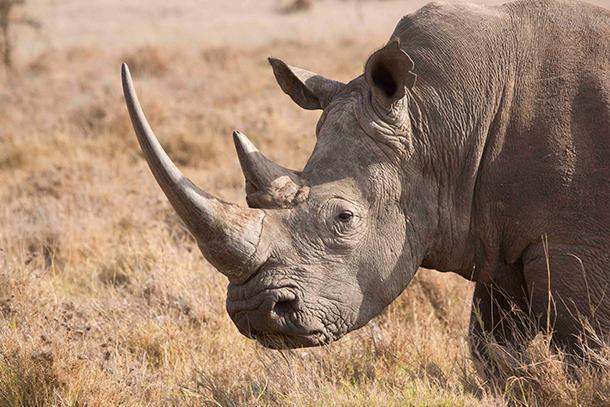Anti-poaching efforts may get a boost from a DNA database for rhino horn
Of the world’s endangered animal species, none faces a more dire situation than rhinos. With just 25,000 or so rhinos left in the world, the threat of extinction looms large.
But now an international database that keeps track of 75 percent of them may offer some hope.
South African law requires that a tissue sample be collected any time a rhino is moved from one park to another or receives medical care. The sample is used to create a DNA profile for each animal that can be recorded and, in case the animal is ever poached, matched to confiscated rhino horn.
It is a race against time, however: More than 1,300 rhinos have already been killed so far in 2016, as poachers go after their horns, which are lucrative commodities in the Asian traditional medicine trade.
The Veterinary Genetics Lab at the University of Pretoria houses the rhino DNA database. The lab has a forensic analysis for roughly 18,000 rhinos, nearly three-quarters of the total population. They hope to eventually register every rhino in the world. The rhino registry helps officials prosecute poaching crimes.
Cindy Harper, director of the lab, says criminals in possession of illegal material like rhino horn might get a slap on the wrist, but if they’re linked to a dead rhino — a crime scene — they will get a much harsher punishment. “We’re looking at cases where poachers get 29 years and more because they are actually involved in an illegal hunt, and not just possession of rhino horn,” Harper says. The sentence for poaching can vary greatly, depending on the country where the poacher was caught.
Rhino poaching is a well-organized, highly profitable crime, run by a heavily-armed international syndicate. Harper says her DNA database allows officers to keep tabs on how poachers are operating. “If you look at it internationally, that gives you some idea of the traceability of where that horn had moved from the carcass to its final destination, and how quickly it moved,” Harper says.
Jorge Rios, chief of the Global Program for Combating Wildlife and Forest Crime at the UN Office on Drugs and Crime, says connecting the dots in this way is critical. The next step is training prosecutors in the countries where rhino horns end up.
“You need to have a number of concurrent processes going,” Rios says. “You need to do the forensics but, even if you have that information, you need to have the criminal legislation in place, and you need to have investigators and prosecutors who know how to use the scientific evidence. You need to train [people] along the entire chain of enforcement.”
DNA technology is also being used to create synthetic rhino horns. Pembient, a biotech company in Seattle, Washington, makes synthetic horns, which they hope to sell at a lower price than real horns and put poachers out of business. But Cindy Harper, from South Africa’s DNA lab, says the synthetic horn is virtually indistinguishable from the real horn, which she believes is actually a bad idea.
“The company that’s currently at the top of this drive wants to put actual DNA into the synthetic horn, and that is something I simply don’t understand,” she says. “I don’t see any other synthetic product, such as synthetic fur or meat or anything else, that has the actual animal’s DNA put into it. The only reason I can think for doing that is to try to make it impossible for law enforcement to differentiate [between real and synthetic].”
Harper says law enforcement agents already have their work cut out for them. She estimates that just one percent of seized rhino horn samples come back to her lab to get matched up on the database.
“That is the next step in the process — making sure that we get these seized samples back, and to be able to look at the whole movement of these horns globally,” Harper says. “The criminals are organized. We need to make sure that everybody else who’s fighting those criminals is equally organized.”
This article is based on a story that aired on PRI’s Living on Earth with Steve Curwood.
